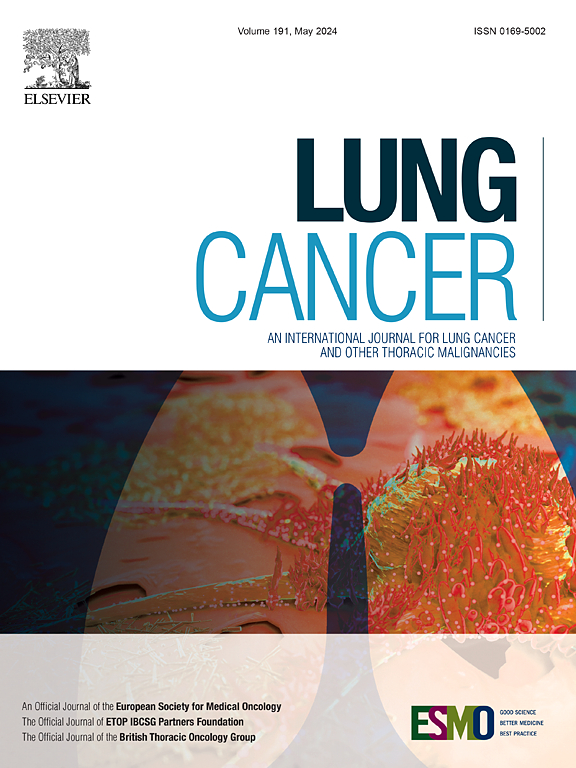实时无创定位在肺叶下切除小结节:一项非劣效性随机临床试验
IF 4.4
2区 医学
Q1 ONCOLOGY
引用次数: 0
摘要
背景:肺叶下切除术是治疗孤立性肺毛玻璃混浊(GGO)病变的一种成熟的手术方法。然而,传统的ct引导下经皮定位与并发症相关,如气胸、血胸和患者不适。为了解决这些问题,一种新的实时、非侵入性定位技术被开发出来。本研究旨在评估这种创新方法在叶下切除过程中定位小肺结节的有效性和安全性。方法于2022年7月至2023年7月在广州医科大学第一附属医院进行非劣效性随机临床试验。患者按1:1随机分为无创定位组和ct引导定位组。主要终点是成功的切除率。次要终点包括切缘距离、手术方案改变、转换率、术中出血量、胸管放置时间、术后住院时间、定位相关并发症和术后并发症以及术后30天死亡率。结果在440例随机患者中,430例接受了手术。无创组和ct引导组的成功切除率相当(98.1% vs 98.6%; P = 0.703)。切缘距离、术中出血量、胸管时间、术后住院时间和术后并发症发生率无显著差异。ct引导组定位相关并发症明显更高,包括定位错位(9.8%)、穿刺部位疼痛(55.8%)、气胸(42.3%)和小出血(30.2%)。无创组未发生定位相关并发症。结论新型无创定位技术与ct引导下的定位在肺叶下切除术中具有相当的有效性,定位相关并发症明显减少,为治疗小肺结节提供了一种更安全的选择。本文章由计算机程序翻译,如有差异,请以英文原文为准。
Real-time non-invasive localization in sub-lobar resection for small pulmonary nodules: a noninferiority randomized clinical trial
Background
Sub-lobar resection is a well-established surgical approach for solitary pulmonary ground-glass opacity (GGO) lesions. However, conventional CT-guided percutaneous localization is associated with complications such as pneumothorax, hemothorax, and patient discomfort. To address these concerns, a novel real-time, non-invasive localization technique was developed. This study aimed to evaluate the effectiveness and safety of this innovative method for localizing small pulmonary nodules during sub-lobar resection.
Methods
A non-inferiority randomized clinical trial was conducted at the First Affiliated Hospital of Guangzhou Medical University from July 2022 to July 2023. Patients were randomized 1:1 to either non-invasive or CT-guided localization. The primary endpoint was the successful resection rate. Secondary endpoints included margin distance, surgical plan changes, conversion rate, intraoperative blood loss, chest tube placement duration, postoperative hospital stay, localization-related and postoperative complications, and 30-day postoperative mortality.
Results
Of the 440 randomized patients, 430 underwent surgery. The successful resection rate was comparable between the non-invasive and CT-guided groups (98.1 % vs. 98.6 %; P = 0.703). No significant differences were observed in margin distance, intraoperative blood loss, chest tube duration, postoperative hospital stay, or postoperative complication rates. Localization-related complications were significantly higher in the CT-guided group, including misplacement (9.8 %), puncture site pain (55.8 %), pneumothorax (42.3 %), and minor hemorrhage (30.2 %). No localization-related complications occurred in the non-invasive group.
Conclusions
The novel non-invasive localization technique demonstrated comparable effectiveness to CT-guided localization for sub-lobar resection, with significantly fewer localization-related complications, offering a safer alternative for managing small pulmonary nodules.
求助全文
通过发布文献求助,成功后即可免费获取论文全文。
去求助
来源期刊

Lung Cancer
医学-呼吸系统
CiteScore
9.40
自引率
3.80%
发文量
407
审稿时长
25 days
期刊介绍:
Lung Cancer is an international publication covering the clinical, translational and basic science of malignancies of the lung and chest region.Original research articles, early reports, review articles, editorials and correspondence covering the prevention, epidemiology and etiology, basic biology, pathology, clinical assessment, surgery, chemotherapy, radiotherapy, combined treatment modalities, other treatment modalities and outcomes of lung cancer are welcome.
 求助内容:
求助内容: 应助结果提醒方式:
应助结果提醒方式:


